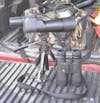Deer in Summer Patterns…for the Most Part
Overall Activity Status: Deer are still going about their regular summer patterns. However, a few signs of the approaching rut...

Overall Activity Status: Deer are still going about their regular summer patterns. However, a few signs of the approaching rut are evident.

Fighting: No fighting yet. Probably the majority of bucks in our Northeast Region are still in the velvet, so they are doing their best to protect the soft antlers (with some exceptions; see below). If you happen to see misshapen antlers, most likely the shape is due to some damage to the antlers while they were in velvet.
Rub & Scrape Making: My scouting partner, Mike Stimmell, saw his first fresh buck rub of this fall. It was behind his house in northwestern Pennsylvania, where he has been watching a pair of young, branched-antlered bucks.
Chasing: Any chasing seen now can be attributed to playfulness.
Daytime Movement: While traveling across northern Ohio last week, I saw deer moving about in the late afternoon, about 5:00 p.m., while a full moon was in the sky. Many hunters, myself included, believe that the moon is one of several natural factors that can influence deer movements. In Mid-Maine, Steve Carpenteri has been watching a couple of younger bucks coming into his bird feeders during daylight hours.
Estrous Signs: There will be no signs of estrous for a while yet. Spotted fawns are still traveling with the does. Once the does start to come into heat they will urge fawns to go elsewhere.
X Factor: Few hunters can actually hunt deer yet. Use this time for scouting, especially from long distances. This will give you your best chance of spotting big, old bucks before they realize you are hunting them. Use strong optics; my long distance deer scouting tools consist of a Bushnell 15-45x spotting scope and Cabela’s Alaskan Guide 12x binoculars. The less bucks know you’re in the area, the better off you will be.